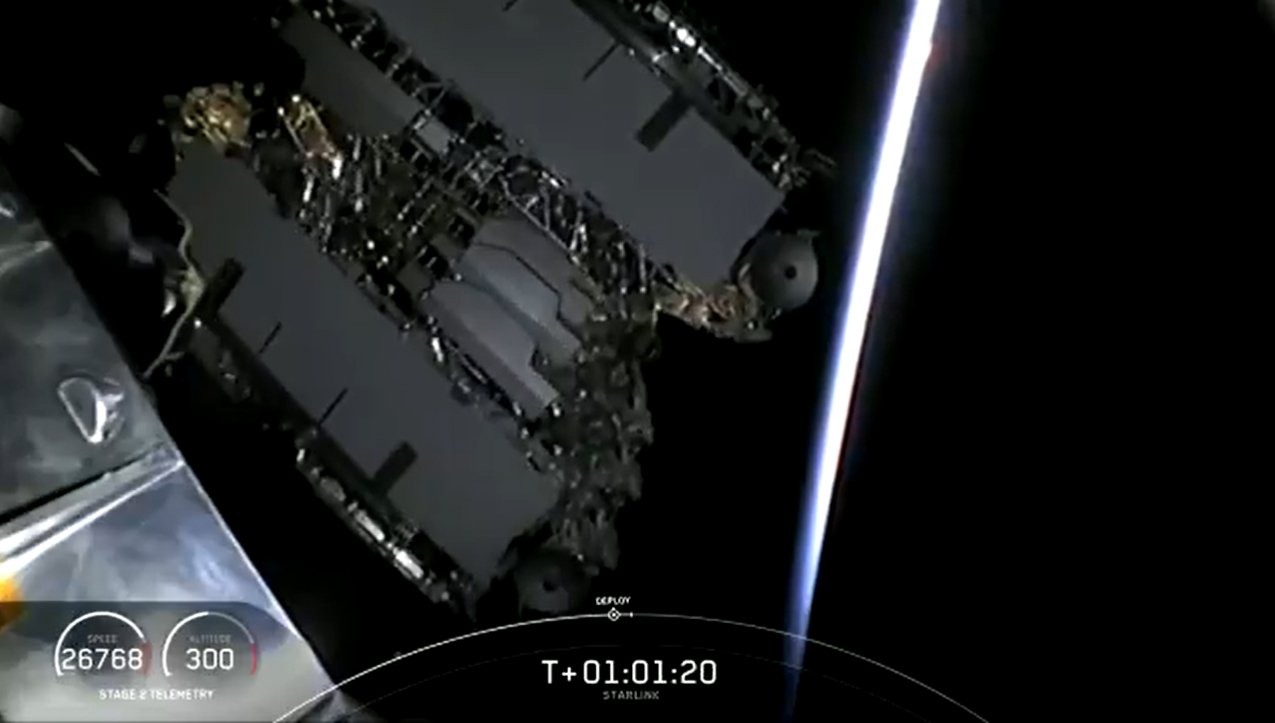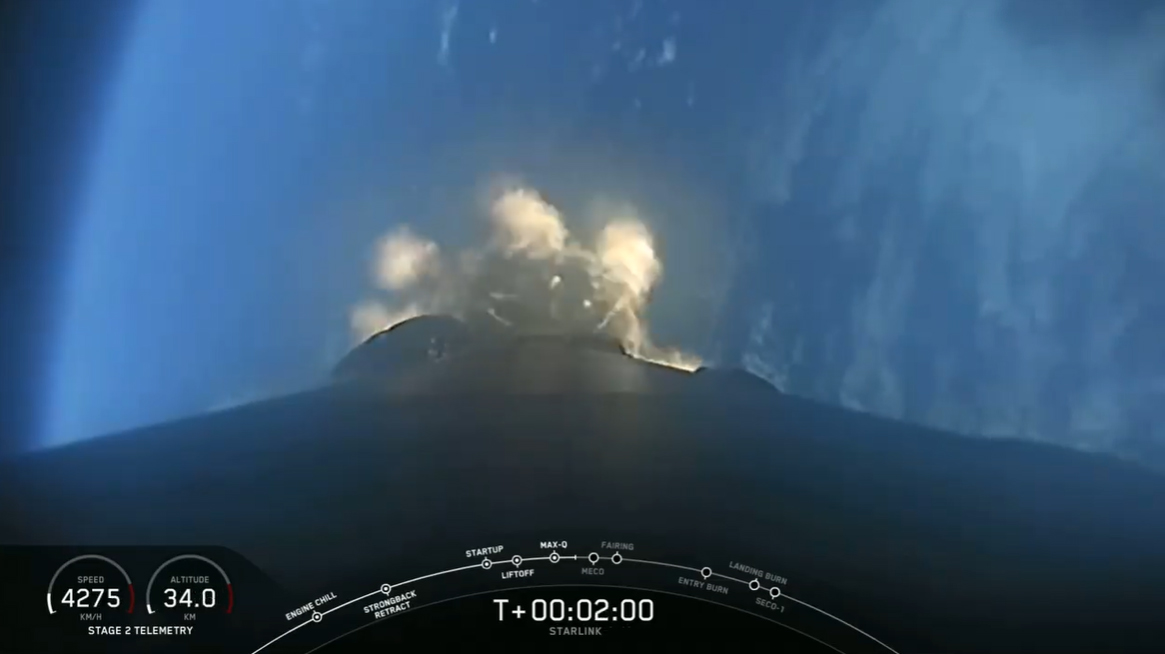How to Spot SpaceX's 60 New Starlink Satellites in the Night Sky
SpaceX launched 60 new satellites into orbit today (Nov. 11). Weather permitting, you just might be able to see the spacecraft swarm soar overhead in your night sky tonight. Of course, you'll need to know where to look.
The new Starlink satellites are the second batch to join SpaceX's growing broadband internet constellation in orbit. They follow the May launch of 60 other satellites that surprised observers with how bright they appeared in the night sky. The night after their launch, those first Starlink satellites appeared as a brilliant string of pearls in the night sky.
"Due to the date and time of launch, conditions for visibility are not so good for Northwest Europe, where I am, nor indeed for the US, as they were in May." Netherlands-based satellite tracker Marco Langbroek, who captured video of the Starlink train in the sky, told Space.com in an email today. That's because the new Starlink satellites have only a few days of evening passes over Europe and the U.S. before shifting into daylight for the near future, he added.
Still, Langbroek added: "Because they seem to aim for a lower operational orbital altitude (350 km) than the previous 60 did (those were inserted at 440 km, so already 100 km higher than what this new batch of 60 aims for, and eventually were brought to 550 km), I expect these new objects to stay relatively bright, i.e. naked eye objects."
So, the new satellites launched today could be visible like their May counterparts for at least the next few nights. So, how to see them?
Video: Watch SpaceX Launch 60 New Starlink Satellites Into Orbit!
The key for any satellite tracker is to know when and where to look. Fortunately, there are several websites that offer forecasts to help amateur observers identify which direction to look and when for any area.
Breaking space news, the latest updates on rocket launches, skywatching events and more!
The tracking site Heavens-Above.com here already has a Starlink Launch 2 page ready. You can visit this Starlink page on the site to see the orbit of the new satellites. The direct link to the Starlink Launch 2 visible passes forecast is here, but don't forget to update the "location" tag in the upper right of the page to get your specific visibility forecast.
The next site to try is N2Y0.com, which automatically picks up your coordinates from your browser to show when and where particular bright satellites (and yes, the International Space Station, too) will be visible.
Another useful site is CalSky here. CalSky asks you to enter the satellite you're looking to spot (either by name or official number, if you know it). You can simply type "Starlink" and click "Go!" to find your personal forecast under "Sightings Opportunities" for each satellite.
"For prospective observers, I would advise to see whether Calsky of Heavens-Above issue predictions for your location, and allow for several minutes uncertainty in the pass time," Langbroek said. "I expect them to be bright now they are still very low, but having binoculars handy would be a good idea. Make sure your eyes are dark adapted (i.e. spent some 125 minutes in the dark at least, avoiding lamplight)."
The "train" view seen in May will likely only be visible over the next two nights, Langbroek said. So, you'll want to be sure to act fast. By the time the satellites are again visible at night, they'll be spread out in their final orbits and less of a sight, Langbroek added.






SpaceX launched the new Starlink satellites into a preliminary orbit of 174 miles (280 kilometers), but each of the 60 satellites is equipped with an ion engine to slowly raise its orbit to an altitude of about 217 miles (350 km).
Not everyone is as thrilled to see SpaceX's Starlink fleet in the night sky as Langbroek was in May, when he called the sight "spectacular."
Astronomers have complained that the bright satellites could endanger scientific observations of the night sky, especially since SpaceX plans to launch at least 12,000 Starlink satellites for its megaconstellation and is eyeing adding another 30,000 satellites in the future. With other companies like Amazon, OneWeb and Telesat planning their own megaconstellations, even Langbroek has concerns.
"I do have concerns about these mega-constellations in low earth orbit. One is
what it will do to our night sky - on a clear summer night, there is always one
or several satellite (s) visible almost at any given moment already," Langbroek said. "With so many to be added over a short time span of only a few years, it will drastically alter how we experience our night sky: the old character of the night sky will basically be lost."
SpaceX CEO Elon Musk has said the company is looking into reducing the brightness of the satellites. Musk and other SpaceX representatives also stress that Starlink satellites are designed for a mission life of between one and 5 years.
At the end of a Starlink satellite's mission, the satellite is designed to use its ion engine to deorbit itself and burn up in Earth's atmosphere to avoid posing a space debris threat to other spacecraft, SpaceX has said.
If you snap a photo or video of SpaceX's Starlink satellites in the night sky and would like to share it with Space.com and our news partners for a story or gallery, you can send images and comments in to spacephotos@space.com.
Editor's note: An earlier version of this story incorrectly stated the orbit intended for this Starlink launch. It is 217 miles (350 kilometers), not 341 miles (550 km).
- SpaceX's Starlink Constellation Could Swell by 30,000 More Satellites
- SpaceX's Starlink Broadband Service Will Begin in 2020: Report
- 'Whoa, It Worked': Elon Musk Tweets Via SpaceX's Starlink Satellites
Email Tariq Malik at tmalik@space.com or follow him @tariqjmalik. Follow us on Twitter @Spacedotcom and on Facebook.


Tariq is the award-winning Editor-in-Chief of Space.com and joined the team in 2001. He covers human spaceflight, as well as skywatching and entertainment. He became Space.com's Editor-in-Chief in 2019. Before joining Space.com, Tariq was a staff reporter for The Los Angeles Times covering education and city beats in La Habra, Fullerton and Huntington Beach. He's a recipient of the 2022 Harry Kolcum Award for excellence in space reporting and the 2025 Space Pioneer Award from the National Space Society. He is an Eagle Scout and Space Camp alum with journalism degrees from the USC and NYU. You can find Tariq at Space.com and as the co-host to the This Week In Space podcast on the TWiT network. To see his latest project, you can follow Tariq on Twitter @tariqjmalik.


